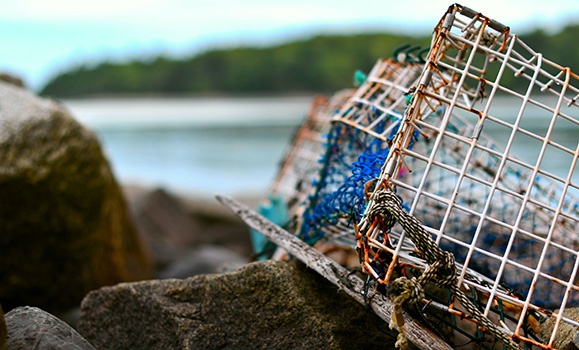Researchers probing one Canada's most productive fishing regions have found the area off Nova Scotia's southern tip is littered with bundles of snarled rope, drifting lobster pots and abandoned buoys that foul the marine environment and take a bite out of the industry's bottom line.
The team of HÂþ» University scientists worked with the Department of Fisheries, fishing captains, volunteers and different fisheries organizations to search for and retrieve abandoned, lost and discarded fishing gear (ALDFG) from three fishing zones that stretch from the Bay of Fundy around to Halifax over two years.
Boats towing hooked grapples over a 4,000-square kilometre swath of seafloor hauled in almost 25,000 kilograms of ALDFG — a motley collection of traps, ropes, hooks, cables and other fishing-related equipment that drift through the water column or rest on the ocean bottom.
Team members, who published their findings May 10 in , also collected almost 5,000 kilograms of assorted gear from seven shoreline searches. Of this, lobster traps made up 68 per cent and dragger cable constituted 12 per cent.
"Ghost gear continues to degrade the environment through marine pollution, but it also poses threats to target and non-target species, including those at risk," says co-author Dr. Tony Walker, an associate professor in Dal's School for Resource and Environmental Studies.
"It also results in economic impacts on an industry on which much of coastal Nova Scotia depends."
A ubiquitous global problem
Retrieved gear varied in type, age, condition and weight, with 30 per cent of lobster traps about one year old while the remaining 70 per cent ranged in age from two to 37 years old. Roughly one-third of all traps retrieved were tagged, useable and less than three to four years old. They were taken to spots where they could be returned to fishers.
The traps contained more than 650 lobsters and almost 60 fish, 42 of which were species at risk, including Atlantic wolffish, Atlantic cod, white hake, spiny dogfish and thorny skate. Most of these were released back into the ocean.
Some retrieved buoys in the Pubnico and Yarmouth areas came from the United States, highlighting the multijurisdictional nature of marine debris and ghost gear, the paper states.
They recovered more than 3,000 kilograms of cable, which was believed to be discarded by commercial trawl vessels when the cable was no longer of use to them.
"Marine debris is a ubiquitous global problem and makes up roughly 58 per cent of macro marine debris by weight," says Leah Fulton, who was doing her Master of Marine Management at HÂþ» at the time and worked with Coastal Action as a mapping technician.
"Once gear enters the water, it can degrade into micro debris, create unsuitable habitat, entangle marine species, cause vessel damage, compromise catches for marine fisheries and create safety hazards in the marine environment."
Recommended reading:ÌýScourge of the sea — How ‘ghost’ fishing gear captures species at risk
Tackling the problem
The researchers stress that ghost gear may be intentionally dumped, but that much of it is likely caused by accidental loss following storms or gear failures.
During 997 tows, the team also brought in buckets, party balloons, a chain, a bicycle tire, an engine block, a fan belt, and an aquaculture net and one of its weights. They also found aquaculture netting, "ultimately informing us that they can also be major contributors to the marine debris problem," says Fulton.Ìý
The fishing grounds in Southwest Nova Scotia span more than 21,000 square kilometres and include Lobster Fishing Areas 33, 34 and 35, which provide most of the country’s lobster supply.
The researchers estimated the economic cost associated with lost gear to be roughly $240,000 per year over the two-year study period from 2019 to 2021. Each retrieved trap contained an average of 1.6 marketable lobsters, representing significant losses to the fishery. HÂþ» eight per cent of lobsters released in LFA 33 were from suspected illegal, unregulated or unreported lobster traps.
The team recommended that DFO increase compliance with ALDFG reporting and that community and fish harvester local knowledge is extensively and consistently gathered before retrieval efforts are conducted.
"This study highlights that gear can be identified and retrieved more effectively than in previous retrieval efforts as techniques and experience have improved," says Dr. Walker.
"Improving end-of-life gear and ALDFG disposal should be supported to reduce the environmental footprint of the fishing industry in marine environments and on land. Ultimately, fishers do not want to lose their gear."

